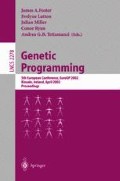Abstract
The loss of genetic diversity in evolutionary algorithms may lead to suboptimal solutions. Many techniques have been developed for maintaining diversity in genetic algorithms, but few investigations have been done for genetic programs. We define here a diversity measure for genetic programs based on our metric for genetic trees [3]. We use this distance measure for studying the effects of fitness sharing. We then propose a method for adaptively maintaining the diversity of a population during evolution.
Access this chapter
Tax calculation will be finalised at checkout
Purchases are for personal use only
Preview
Unable to display preview. Download preview PDF.
References
W. Banzhaf, P. Nordin, R. E. Keller, and F. D. Francone, Genetic Programming: An Introduction, Morgan Kaufmann, 1998.
U. Bohnebeck, T. Horváth, and S. Wrobel, Term comparisons in first-order similarity measures, in Proceedings of the 8th International Workshop on Inductive Logic Programming, ed., D. Page, volume 1446 of LNAI, pp. 65–79. Springer-Verlag, (1998).
A. Ekárt and S. Z. Németh, A metric for genetic programs and fitness sharing, in Proceedings of EUROGP’2000, eds., R. Poli, W. Banzhaf, W. B. Langdon, J. Miller, P. Nordin, and T. Fogarty, volume 1802 of LNCS, pp. 259–270. Springer-Verlag, (2000).
R. Feldt, Using genetic programming to systematically force software diversity, Tech. rep. nr. 296l, Chalmers University of Technology, (1998).
D. E. Goldberg, Genetic Algorithms in Search, Optimization, and Machine Learning, Addison-Wesley, 1989.
C. Igel and K. Chellapilla, Investigating the influence of depth and degree of genotypic change on fitness in genetic programming, in GECCO-99: Proceedings of the Genetic and Evolutionary Computation Conference, eds., W. Banzhaf, J. Daida, A. E. Eiben, M. H. Garzon, V. Honavar, M. Jakiela, and R. E. Smith, pp. 1061–1068, (1999).
Maarten Keijzer, Efficiently representing populations in genetic programming, in Advances in Genetic Programming 2, eds., Peter J. Angeline and Kenneth E. Kinnear, 259–278, MIT Press, (1996).
R. E. Keller and W. Banzhaf, Explicit maintenance of genetic diversity on genospaces, Technical report, Dortmund University, (1994).
John R. Koza, Genetic Programming: On the Programming of Computers by Means of Natural Selection, MIT Press, 1992.
William B. Langdon, Genetic Programming and Data Structures: Genetic Programming + Data Structures = Automatic Programming!, Kluwer Academic, 1998.
S.-Y. Lu, The tree-to-tree distance and its application to cluster analysis, IEEE Transactions on PAMI, 1(2), 219–224, (1979).
Una-May O’Reilly, Using a distance metric on genetic programs to understand genetic operators, in Late Breaking Papers at the 1997 Genetic Programming Conference, ed., John R. Koza, pp. 199–206, (1997).
J. P. Rosca, Genetic programming exploratory power and the discovery of functions, in Proceedings of the Fourth Annual Conference on Evolutionary Programming, pp. 719–736, (1995).
S. M. Selkow, The tree-to-tree editing problem, Information Processing Letters, 6(6), 184–186, (1977).
K.-C. Tai, The tree-to-tree correction problem,Journal of the ACM, 26(3), 422–433, (1979).
Author information
Authors and Affiliations
Editor information
Editors and Affiliations
Rights and permissions
Copyright information
© 2002 Springer-Verlag Berlin Heidelberg
About this paper
Cite this paper
Ekárt, A., Németh, S.Z. (2002). Maintaining the Diversity of Genetic Programs. In: Foster, J.A., Lutton, E., Miller, J., Ryan, C., Tettamanzi, A. (eds) Genetic Programming. EuroGP 2002. Lecture Notes in Computer Science, vol 2278. Springer, Berlin, Heidelberg. https://doi.org/10.1007/3-540-45984-7_16
Download citation
DOI: https://doi.org/10.1007/3-540-45984-7_16
Published:
Publisher Name: Springer, Berlin, Heidelberg
Print ISBN: 978-3-540-43378-1
Online ISBN: 978-3-540-45984-2
eBook Packages: Springer Book Archive

